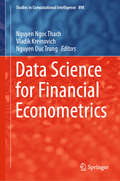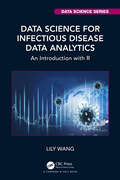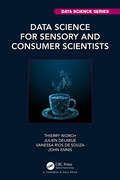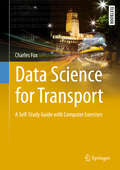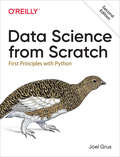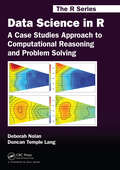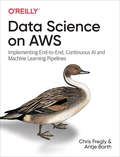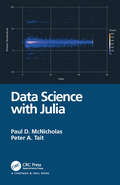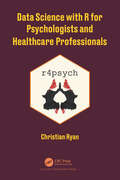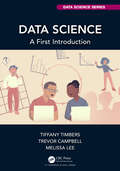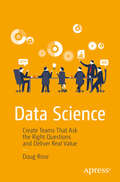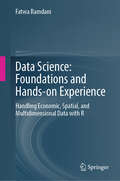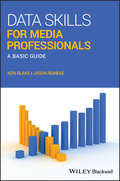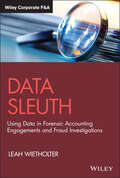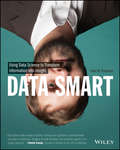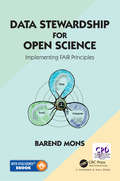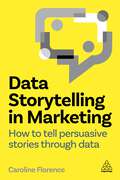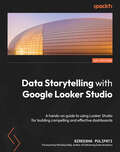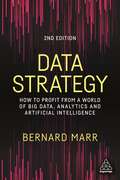- Table View
- List View
Data Science for Entrepreneurship: Principles and Methods for Data Engineering, Analytics, Entrepreneurship, and the Society (Classroom Companion: Business)
by Willem-Jan Van den Heuvel Damian A. Tamburri Florian Böing-Messing Werner Liebregts Anne J. LafarreThe fast-paced technological development and the plethora of data create numerous opportunities waiting to be exploited by entrepreneurs. This book provides a detailed, yet practical, introduction to the fundamental principles of data science and how entrepreneurs and would-be entrepreneurs can take advantage of it. It walks the reader through sections on data engineering, and data analytics as well as sections on data entrepreneurship and data use in relation to society. The book also offers ways to close the research and practice gaps between data science and entrepreneurship. By having read this book, students of entrepreneurship courses will be better able to commercialize data-driven ideas that may be solutions to real-life problems. Chapters contain detailed examples and cases for a better understanding. Discussion points or questions at the end of each chapter help to deeply reflect on the learning material.
Data Science for Financial Econometrics (Studies in Computational Intelligence #898)
by Vladik Kreinovich Nguyen Ngoc Thach Nguyen Duc TrungThis book offers an overview of state-of-the-art econometric techniques, with a special emphasis on financial econometrics. There is a major need for such techniques, since the traditional way of designing mathematical models – based on researchers’ insights – can no longer keep pace with the ever-increasing data flow. To catch up, many application areas have begun relying on data science, i.e., on techniques for extracting models from data, such as data mining, machine learning, and innovative statistics. In terms of capitalizing on data science, many application areas are way ahead of economics. To close this gap, the book provides examples of how data science techniques can be used in economics. Corresponding techniques range from almost traditional statistics to promising novel ideas such as quantum econometrics. Given its scope, the book will appeal to students and researchers interested in state-of-the-art developments, and to practitioners interested in using data science techniques.
Data Science for Infectious Disease Data Analytics: An Introduction with R (Chapman & Hall/CRC Data Science Series)
by Lily WangData Science for Infectious Disease Data Analytics: An Introduction with R provides an overview of modern data science tools and methods that have been developed specifically to analyze infectious disease data. With a quick start guide to epidemiological data visualization and analysis in R, this book spans the gulf between academia and practices providing many lively, instructive data analysis examples using the most up-to-date data, such as the newly discovered coronavirus disease (COVID-19). The primary emphasis of this book is the data science procedures in epidemiological studies, including data wrangling, visualization, interpretation, predictive modeling, and inference, which is of immense importance due to increasingly diverse and nonexperimental data across a wide range of fields. The knowledge and skills readers gain from this book are also transferable to other areas, such as public health, business analytics, environmental studies, or spatio-temporal data visualization and analysis in general. Aimed at readers with an undergraduate knowledge of mathematics and statistics, this book is an ideal introduction to the development and implementation of data science in epidemiology. Features Describes the entire data science procedure of how the infectious disease data are collected, curated, visualized, and fed to predictive models, which facilitates effective communication between data sources, scientists, and decision-makers. Explains practical concepts of infectious disease data and provides particular data science perspectives. Overview of the unique features and issues of infectious disease data and how they impact epidemic modeling and projection. Introduces various classes of models and state-of-the-art learning methods to analyze infectious diseases data with valuable insights on how different models and methods could be connected.
Data Science for Nano Image Analysis (International Series in Operations Research & Management Science #308)
by Yu Ding Chiwoo ParkThis book combines two distinctive topics: data science/image analysis and materials science. The purpose of this book is to show what type of nano material problems can be better solved by which set of data science methods. The majority of material science research is thus far carried out by domain-specific experts in material engineering, chemistry/chemical engineering, and mechanical & aerospace engineering. The book could benefit materials scientists and manufacturing engineers who were not exposed to systematic data science training while in schools, or data scientists in computer science or statistics disciplines who want to work on material image problems or contribute to materials discovery and optimization.This book provides in-depth discussions of how data science and operations research methods can help and improve nano image analysis, automating the otherwise manual and time-consuming operations for material engineering and enhancing decision making for nano material exploration. A broad set of data science methods are covered, including the representations of images, shape analysis, image pattern analysis, and analysis of streaming images, change points detection, graphical methods, and real-time dynamic modeling and object tracking. The data science methods are described in the context of nano image applications, with specific material science case studies.
Data Science for Sensory and Consumer Scientists (Chapman & Hall/CRC Data Science Series)
by John Ennis Thierry Worch Julien Delarue Vanessa Rios De SouzaData Science for Sensory and Consumer Scientists is a comprehensive textbook that provides a practical guide to using data science in the field of sensory and consumer science through real-world applications. It covers key topics including data manipulation, preparation, visualization, and analysis, as well as automated reporting, machine learning, text analysis, and dashboard creation. Written by leading experts in the field, this book is an essential resource for anyone looking to master the tools and techniques of data science and apply them to the study of consumer behavior and sensory-led product development. Whether you are a seasoned professional or a student just starting out, this book is the ideal guide to using data science to drive insights and inform decision-making in the sensory and consumer sciences. Key Features: • Elucidation of data scientific workflow. • Introduction to reproducible research. • In-depth coverage of data-scientific topics germane to sensory and consumer science. • Examples based in industrial practice used throughout the book
Data Science for Transport: A Self-study Guide With Computer Exercises (Springer Textbooks In Earth Sciences, Geography And Environment Ser.)
by Charles FoxThe quantity, diversity and availability of transport data is increasing rapidly, requiring new skills in the management and interrogation of data and databases. Recent years have seen a new wave of 'big data', 'Data Science', and 'smart cities' changing the world, with the Harvard Business Review describing Data Science as the "sexiest job of the 21st century". Transportation professionals and researchers need to be able to use data and databases in order to establish quantitative, empirical facts, and to validate and challenge their mathematical models, whose axioms have traditionally often been assumed rather than rigorously tested against data. This book takes a highly practical approach to learning about Data Science tools and their application to investigating transport issues. The focus is principally on practical, professional work with real data and tools, including business and ethical issues."Transport modeling practice was developed in a data poor world, and many of our current techniques and skills are building on that sparsity. In a new data rich world, the required tools are different and the ethical questions around data and privacy are definitely different. I am not sure whether current professionals have these skills; and I am certainly not convinced that our current transport modeling tools will survive in a data rich environment. This is an exciting time to be a data scientist in the transport field. We are trying to get to grips with the opportunities that big data sources offer; but at the same time such data skills need to be fused with an understanding of transport, and of transport modeling. Those with these combined skills can be instrumental at providing better, faster, cheaper data for transport decision- making; and ultimately contribute to innovative, efficient, data driven modeling techniques of the future. It is not surprising that this course, this book, has been authored by the Institute for Transport Studies. To do this well, you need a blend of academic rigor and practical pragmatism. There are few educational or research establishments better equipped to do that than ITS Leeds". - Tom van Vuren, Divisional Director, Mott MacDonald"WSP is proud to be a thought leader in the world of transport modelling, planning and economics, and has a wide range of opportunities for people with skills in these areas. The evidence base and forecasts we deliver to effectively implement strategies and schemes are ever more data and technology focused a trend we have helped shape since the 1970's, but with particular disruption and opportunity in recent years. As a result of these trends, and to suitably skill the next generation of transport modellers, we asked the world-leading Institute for Transport Studies, to boost skills in these areas, and they have responded with a new MSc programme which you too can now study via this book." - Leighton Cardwell, Technical Director, WSP."From processing and analysing large datasets, to automation of modelling tasks sometimes requiring different software packages to "talk" to each other, to data visualization, SYSTRA employs a range of techniques and tools to provide our clients with deeper insights and effective solutions. This book does an excellent job in giving you the skills to manage, interrogate and analyse databases, and develop powerful presentations. Another important publication from ITS Leeds." - Fitsum Teklu, Associate Director (Modelling & Appraisal) SYSTRA Ltd"Urban planning has relied for decades on statistical and computational practices that have little to do with mainstream data science. Information is still often used as evidence on the impact of new infrastructure even when it hardly contains any valid evidence. This book is an extremely welcome effort to provide young professionals with the skills needed to analyse how cities and transport networks actually work. The book is also highly relevant to anyone who will later want to build digital solutions to optimise urban travel based on emerging data sources". - Yaron Hollander, author of "T
Data Science from Scratch: First Principles with Python
by Joel GrusData science libraries, frameworks, modules, and toolkits are great for doing data science, but they’re also a good way to dive into the discipline without actually understanding data science. With this updated second edition, you’ll learn how many of the most fundamental data science tools and algorithms work by implementing them from scratch.If you have an aptitude for mathematics and some programming skills, author Joel Grus will help you get comfortable with the math and statistics at the core of data science, and with hacking skills you need to get started as a data scientist. Today’s messy glut of data holds answers to questions no one’s even thought to ask. This book provides you with the know-how to dig those answers out.
Data Science in R: A Case Studies Approach to Computational Reasoning and Problem Solving (Chapman And Hall/crc The R Ser. #26)
by Deborah Nolan Duncan Temple LangEffectively Access, Transform, Manipulate, Visualize, and Reason about Data and ComputationData Science in R: A Case Studies Approach to Computational Reasoning and Problem Solving illustrates the details involved in solving real computational problems encountered in data analysis. It reveals the dynamic and iterative process by which data analysts
Data Science of Renewable Energy Integration: The Nexus of Energy, Environment, and Economic Growth (Evolutionary Economics and Social Complexity Science #30)
by Yuichi IkedaThis book covers various data scientific approaches to analyze the issue of grid integration of renewable energy for which the grid flexibility is the key to cope with its intermittency. It provides readers with the scope to view renewable energy integration as establishing a distributed energy network instead of the traditional centralized energy system. Specifically, quantitative valuation system-wise of the levelized cost of energy, which includes both initial cost and various operational costs, enables readers to optimize energy systems in order to minimize economic cost and environmental impact. It is noted, however, that the high cost of integrating renewable energy on a large scale might slow economic growth considerably. Topics addressed in the book also include statistical comparative study of the relationship between energy and economic growth, a graphical model of determinant factors for foreign direct investment in renewable energy, the coupled oscillator model and unit commitment model to capture intermittency of renewable energy, and the network model of evolving micro-grids. The book explains desired innovation to reduce the integration cost significantly using innovative technologies such as energy storage with hydrogen production and vehicle-to-grid technology. Illustrated by careful analysis of selected examples of renewable integration using different types of grid flexibility, this volume is indispensable to readers who make policy recommendations to establish the distributed energy network integrated with large-scale renewable energy by disentangling the nexus of energy, environment, and economic growth.
Data Science on AWS: Implementing End-to-end, Continuous Ai And Machine Learning Pipelines
by Chris Fregly Antje BarthWith this practical book, AI and machine learning practitioners will learn how to successfully build and deploy data science projects on Amazon Web Services. The Amazon AI and machine learning stack unifies data science, data engineering, and application development to help level up your skills. This guide shows you how to build and run pipelines in the cloud, then integrate the results into applications in minutes instead of days. Throughout the book, authors Chris Fregly and Antje Barth demonstrate how to reduce cost and improve performance.Apply the Amazon AI and ML stack to real-world use cases for natural language processing, computer vision, fraud detection, conversational devices, and moreUse automated machine learning to implement a specific subset of use cases with SageMaker AutopilotDive deep into the complete model development lifecycle for a BERT-based NLP use case including data ingestion, analysis, model training, and deploymentTie everything together into a repeatable machine learning operations pipelineExplore real-time ML, anomaly detection, and streaming analytics on data streams with Amazon Kinesis and Managed Streaming for Apache KafkaLearn security best practices for data science projects and workflows including identity and access management, authentication, authorization, and more
Data Science und Statistik mit R: Anwendungslösungen für die Praxis
by Bernd HeesenData Science trägt wesentlich zu einer schnelleren Nutzbarmachung von Markt-, Kunden- und Nutzerdaten bei, inklusive der Analyse von Daten aus Sozialen Netzwerken. Wo früher klassische Statistik für Berechnungen und Vorhersagen herangezogen wurde, da erlauben heute Open-Source-Werkzeuge wie R Daten in unterschiedlichsten Formaten und aus beliebig vielen Quellen für die Analyse einzulesen, aufzubereiten und mit Hilfe von Methoden der Künstlichen Intelligenz und des Machine Learning zu analysieren. Die Ergebnisse können dann anschließend perfekt visuell dargestellt werden, so dass die Entscheider schnell und effektiv davon profitieren können. Daraus lässt sich ableiten, welche Maßnahmen mit einer vorhersagbaren Wahrscheinlichkeit zur Erreichung der eigenen Ziele geeignet sind, z.B. welcher Preis für ein Angebot die gewünschte Nachfrage erzeugt oder welche Marketingmaßnahme eine gewünschte Zielgruppe erreicht.Dieses Buch vermittelt auf Basis von R, wie Sie Statistik, Data Science, Künstliche Intelligenz und Machine Learning in der Industrie 4.0 nutzen können. Die Anwendungsbeispiele können von Lesern selbst durchgeführt werden, da das Buch die R-Anweisungen beinhaltet. Damit ist das Buch ideal für Studierende und andere Interessierte, die sich Kenntnisse in der Statistiklösung R aneignen wollen.
Data Science with Julia
by Peter Tait Paul McNicholas"This book is a great way to both start learning data science through the promising Julia language and to become an efficient data scientist."- Professor Charles Bouveyron, INRIA Chair in Data Science, Université Côte d’Azur, Nice, France Julia, an open-source programming language, was created to be as easy to use as languages such as R and Python while also as fast as C and Fortran. An accessible, intuitive, and highly efficient base language with speed that exceeds R and Python, makes Julia a formidable language for data science. Using well known data science methods that will motivate the reader, Data Science with Julia will get readers up to speed on key features of the Julia language and illustrate its facilities for data science and machine learning work. Features: Covers the core components of Julia as well as packages relevant to the input, manipulation and representation of data. Discusses several important topics in data science including supervised and unsupervised learning. Reviews data visualization using the Gadfly package, which was designed to emulate the very popular ggplot2 package in R. Readers will learn how to make many common plots and how to visualize model results. Presents how to optimize Julia code for performance. Will be an ideal source for people who already know R and want to learn how to use Julia (though no previous knowledge of R or any other programming language is required). The advantages of Julia for data science cannot be understated. Besides speed and ease of use, there are already over 1,900 packages available and Julia can interface (either directly or through packages) with libraries written in R, Python, Matlab, C, C++ or Fortran. The book is for senior undergraduates, beginning graduate students, or practicing data scientists who want to learn how to use Julia for data science. "This book is a great way to both start learning data science through the promising Julia language and to become an efficient data scientist." Professor Charles BouveyronINRIA Chair in Data ScienceUniversité Côte d’Azur, Nice, France
Data Science with R for Psychologists and Healthcare Professionals
by Christian RyanThis introduction to R for students of psychology and health sciences aims to fast-track the reader through some of the most difficult aspects of learning to do data analysis and statistics. It demonstrates the benefits for reproducibility and reliability of using a programming language over commercial software packages such as SPSS. The early chapters build at a gentle pace, to give the reader confidence in moving from a point-and-click software environment, to the more robust and reliable world of statistical coding. This is a thoroughly modern and up-to-date approach using RStudio and the tidyverse. A range of R packages relevant to psychological research are discussed in detail. A great deal of research in the health sciences concerns questionnaire data, which may require recoding, aggregation and transformation before quantitative techniques and statistical analysis can be applied. R offers many useful and transparent functions to process data and check psychometric properties. These are illustrated in detail, along with a wide range of tools R affords for data visualisation. Many introductory statistics books for the health sciences rely on toy examples - in contrast, this book benefits from utilising open datasets from published psychological studies, to both motivate and demonstrate the transition from data manipulation and analysis to published report. R Markdown is becoming the preferred method for communicating in the open science community. This book also covers the detail of how to integrate the use of R Markdown documents into the research workflow and how to use these in preparing manuscripts for publication, adhering to the latest APA style guidelines.
Data Science, AI, and Machine Learning in Drug Development (Chapman & Hall/CRC Biostatistics Series)
by Harry YangThe confluence of big data, artificial intelligence (AI), and machine learning (ML) has led to a paradigm shift in how innovative medicines are developed and healthcare delivered. To fully capitalize on these technological advances, it is essential to systematically harness data from diverse sources and leverage digital technologies and advanced analytics to enable data-driven decisions. Data science stands at a unique moment of opportunity to lead such a transformative change. Intended to be a single source of information, Data Science, AI, and Machine Learning in Drug Research and Development covers a wide range of topics on the changing landscape of drug R & D, emerging applications of big data, AI and ML in drug development, and the build of robust data science organizations to drive biopharmaceutical digital transformations. Features Provides a comprehensive review of challenges and opportunities as related to the applications of big data, AI, and ML in the entire spectrum of drug R & D Discusses regulatory developments in leveraging big data and advanced analytics in drug review and approval Offers a balanced approach to data science organization build Presents real-world examples of AI-powered solutions to a host of issues in the lifecycle of drug development Affords sufficient context for each problem and provides a detailed description of solutions suitable for practitioners with limited data science expertise
Data Science: A First Introduction (Chapman & Hall/CRC Data Science Series)
by Tiffany Timbers Trevor Campbell Melissa LeeData Science: A First Introduction focuses on using the R programming language in Jupyter notebooks to perform data manipulation and cleaning, create effective visualizations, and extract insights from data using classification, regression, clustering, and inference. The text emphasizes workflows that are clear, reproducible, and shareable, and includes coverage of the basics of version control. All source code is available online, demonstrating the use of good reproducible project workflows. Based on educational research and active learning principles, the book uses a modern approach to R and includes accompanying autograded Jupyter worksheets for interactive, self-directed learning. The book will leave readers well-prepared for data science projects. The book is designed for learners from all disciplines with minimal prior knowledge of mathematics and programming. The authors have honed the material through years of experience teaching thousands of undergraduates in the University of British Columbia’s DSCI100: Introduction to Data Science course.
Data Science: Create Teams That Ask the Right Questions and Deliver Real Value
by Doug RoseLearn how to build a data science team within your organization rather than hiring from the outside. Teach your team to ask the right questions to gain actionable insights into your business. Most organizations still focus on objectives and deliverables. Instead, a data science team is exploratory. They use the scientific method to ask interesting questions and run small experiments. Your team needs to see if the data illuminate their questions. Then, they have to use critical thinking techniques to justify their insights and reasoning. They should pivot their efforts to keep their insights aligned with business value. Finally, your team needs to deliver these insights as a compelling story. Insight!: How to Build Data Science Teams that Deliver Real Business Value shows that the most important thing you can do now is help your team think about data. Management coach Doug Rose walks you through the process of creating and managing effective data science teams. You will learn how to find the right people inside your organization and equip them with the right mindset. The book has three overarching concepts: You should mine your own company for talent. You can't change your organization by hiring a few data science superheroes. You should form small, agile-like data teams that focus on delivering valuable insights early and often. You can make real changes to your organization by telling compelling data stories. These stories are the best way to communicate your insights about your customers, challenges, and industry. What Your Will Learn: Create data science teams from existing talent in your organization to cost-efficiently extract maximum business value from your organization's data Understand key data science terms and concepts Follow practical guidance to create and integrate an effective data science team with key roles and the responsibilities for each team member Utilize the data science life cycle (DSLC) to model essential processes and practices for delivering value Use sprints and storytelling to help your team stay on track and adapt to new knowledge Who This Book Is For Data science project managers and team leaders. The secondary readership is data scientists, DBAs, analysts, senior management, HR managers, and performance specialists.
Data Science: Handling Economic, Spatial, and Multidimensional Data with R
by Fatwa RamdaniThis book will take readers from foundational concepts to practical applications, enabling them to transform raw data into meaningful insights. It covers key skills such as data collection, cleaning, organization, exploration, analysis, and impactful presentation—core competencies for navigating today&’s data-rich landscape. Each chapter is designed to build both theoretical understanding and hands-on expertise. The book&’s unique dual-approach structure introduces foundational data science concepts, followed by exercises in RStudio using real-world datasets from social fields. This blend of theory and practice ensures readers grasp the &‘how&’ and the &‘why&’ behind data-driven research, making it ideal for students, researchers, and professionals seeking to enhance their analytical capabilities. Spatial data analysis stands out as one of the most unique in this book because it focuses on spatial data, a topic rarely covered in data science references. While there are many resources on data science, few explore the unique aspects of spatial data. Nowadays, most data includes location information, which can greatly enhance data science and decision-making. The final chapter will discuss critical topics in data ethics and reproducibility, encouraging readers to think responsibly about data use. By the end, readers will gain not only technical skills but also ethical awareness, empowering them to conduct rigorous, reliable, and socially conscious research. No prior experience with data science is required—just an eagerness to explore the power of data in understanding and shaping society. This textbook is suitable for adoption in both undergraduate and graduate classes. The book will help students build a solid theoretical foundation in data science while gaining hands-on experience with RStudio.
Data Science: Konzepte, Erfahrungen, Fallstudien und Praxis
by Andreas Gadatsch Andreas Schmidt Christoph Quix Uwe Schmitz Detlev Frick Jens Kaufmann Birgit LankesData Science ist in vielen Organisationen angekommen und oft alltägliche Praxis. Dennoch stehen viele Verantwortliche vor der Herausforderung, sich erstmalig mit konkreten Fragestellungen zu beschäftigen oder laufende Projekte weiterzuentwickeln. Die Spannbreite der Methoden, Werkzeuge und Anwendungsmöglichkeiten ist sehr groß und entwickelt sich kontinuierlich weiter. Die Vielzahl an Publikationen zu Data Science ist spezialisiert und behandelt fokussiert Einzelaspekte. Das vorliegende Werk gibt den Leserinnen und Lesern eine umfassende Orientierung zum Status Quo aus der wissenschaftlichen Perspektive und zahlreiche vertiefende Darstellungen praxisrelevanter Aspekte. Die Inhalte bauen auf den wissenschaftlichen CAS-Zertifikatskursen zu Big Data und Data Science der Hochschule Niederrhein in Kooperation mit der Hochschule Bonn-Rhein-Sieg und der FH Dortmund auf. Sie berücksichtigen wissenschaftliche Grundlagen und Vertiefungen, aber auch konkrete Erfahrungen aus Data Science Projekten. Das Buch greift praxisrelevante Fragen auf wissenschaftlichem Niveau aus Sicht der Rollen eines „Data Strategist“, „Data Architect“ und „Data Analyst“ auf und bindet erprobte Praxiserfahrungen u. a. von Seminarteilnehmern mit ein. Das Buch gibt für Interessierte einen Einblick in die aktuell relevante Vielfalt der Aspekte zu Data Science bzw. Big Data und liefert Hinweise für die praxisnahe Umsetzung.
Data Skills for Media Professionals: A Basic Guide
by Ken Blake Jason ReinekeTeaches the basic, yet all-important, data skills required by today’s media professionals The authors of Data Skills for Media Professionals have assembled a book that teaches key aspects of data analysis, interactive data visualization and online map-making through an introduction to Google Drive, Google Sheets, and Google My Maps, all free, highly intuitive, platform-agnostic tools available to any reader with a computer and a web connection. Delegating the math and design work to these apps leaves readers free to do the kinds of thinking that media professionals do most often: considering what questions to ask, how to ask them, and how to evaluate and communicate the answers. Although focused on Google apps, the book draws upon complementary aspects of the free QGIS geographic information system, the free XLMiner Analysis ToolPak Add-on for Google Sheets, and the ubiquitous Microsoft Excel spreadsheet application. Worked examples rely on frequently updated data from the U.S. Bureau of Labor Statistics, the Federal Election Commission, the National Bridge Inventory of structurally deficient bridges, and other federal sources, giving readers the option of immediately applying what they learn to current data they can localize to any area in the United States. The book offers chapters covering: basic data analysis; data visualization; making online maps; Microsoft Excel and pivot tables; matching records with Excel's VLOOKUP function; basic descriptive and inferential statistics; and other functions, tools and techniques. Serves as an excellent supplemental text for easily adding data skills instruction to courses in beginning or advanced writing and reporting Features computer screen captures that illustrate each step of each procedure Offers downloadable datasets from a companion web page to help students implement the techniques themselves Shows realistic examples that illustrate how to perform each technique and how to use it on the job Data Skills of Media Professionals is an excellent book for students taking skills courses in the more than 100 ACEJMC-accredited journalism and mass communication programs across the United States. It would also greatly benefit those enrolled in advanced or specialized reporting courses, including courses dedicated solely to teaching data skills.
Data Sleuth: Using Data in Forensic Accounting Engagements and Fraud Investigations (Wiley Corporate F&A)
by Leah WietholterStraightforward, practical guidance for working fraud examiners and forensic accountants In Data Sleuth: Using Data in Forensic Accounting Engagements and Fraud Investigations, certified fraud examiner, former FBI support employee, private investigator, and certified public accountant Leah Wietholter delivers a step-by-step guide to financial investigation that can be applied to almost any forensic accounting use-case. The book emphasizes the use of best evidence as you work through problem-solving data analysis techniques that address the common challenge of imperfect and incomplete information. The accomplished author bridges the gap between modern fraud investigation theory and practical applications and processes necessary for working practitioners. She also provides: Access to a complimentary website with supplementary resources, including a Fraud Detection Worksheet and case planning template Strategies for systematically applying the Data Sleuth® framework to streamline and grow your practice Methods and techniques to improve the quality of your work productData Sleuth is an indispensable, hands-on resource for practicing and aspiring fraud examiners and investigators, accountants, and auditors. It’s a one-of-a-kind book that puts a practical blueprint to effective financial investigation in the palm of your hand.
Data Smart
by John W. ForemanData Science gets thrown around in the press like it's magic. Major retailers are predicting everything from when their customers are pregnant to when they want a new pair of Chuck Taylors. It's a brave new world where seemingly meaningless data can be transformed into valuable insight to drive smart business decisions.But how does one exactly do data science? Do you have to hire one of these priests of the dark arts, the "data scientist," to extract this gold from your data? Nope.Data science is little more than using straight-forward steps to process raw data into actionable insight. And in Data Smart, author and data scientist John Foreman will show you how that's done within the familiar environment of a spreadsheet. Why a spreadsheet? It's comfortable! You get to look at the data every step of the way, building confidence as you learn the tricks of the trade. Plus, spreadsheets are a vendor-neutral place to learn data science without the hype. But don't let the Excel sheets fool you. This is a book for those serious about learning the analytic techniques, the math and the magic, behind big data. Each chapter will cover a different technique in a spreadsheet so you can follow along:Mathematical optimization, including non-linear programming and genetic algorithmsClustering via k-means, spherical k-means, and graph modularityData mining in graphs, such as outlier detectionSupervised AI through logistic regression, ensemble models, and bag-of-words modelsForecasting, seasonal adjustments, and prediction intervals through monte carlo simulationMoving from spreadsheets into the R programming languageYou get your hands dirty as you work alongside John through each technique. But never fear, the topics are readily applicable and the author laces humor throughout. You'll even learn what a dead squirrel has to do with optimization modeling, which you no doubt are dying to know.
Data Stewardship for Open Science: Implementing FAIR Principles
by Barend MonsData Stewardship for Open Science: Implementing FAIR Principles has been written with the intention of making scientists, funders, and innovators in all disciplines and stages of their professional activities broadly aware of the need, complexity, and challenges associated with open science, modern science communication, and data stewardship. The FAIR principles are used as a guide throughout the text, and this book should leave experimentalists consciously incompetent about data stewardship and motivated to respect data stewards as representatives of a new profession, while possibly motivating others to consider a career in the field. The ebook, avalable for no additional cost when you buy the paperback, will be updated every 6 months on average (providing that significant updates are needed or avaialble). Readers will have the opportunity to contribute material towards these updates, and to develop their own data management plans, via the free Data Stewardship Wizard.
Data Storytelling in Marketing: How to Tell Persuasive Stories Through Data
by Caroline FlorenceMarketers are storytellers, they write content, marketing strategies and devise internal communications, but unless these stories are evidence-based, they won't be believable or truly persuasive. Understanding how to use data to build and tell stories is an increasingly important part of the modern-day marketers' toolkit. Stories centered on robust evidence and credible data can withstand challenges, provide meaning, offer insight and engage audiences.This book is designed to plug the data storytelling skills gap and enable marketing professionals to cut through the data overload, join the data dots and create engaging narratives and content. Regardless of whether you're a data expert, data anxious or a data sceptic, this book will give you the tools to help you to communicate more effectively with your customers and your stakeholders. Written by expert trainer Caroline Florence, this book outlines how to build robust and compelling data stories. Drawing on her client work with companies such as Toyota, Lactalis, News UK, Mars Petcare and AXA, plus contributions from experts across data, insights, marketing and customer experience, this book provides a practical roadmap to increase your influence with data storytelling.
Data Storytelling with Google Looker Studio: A hands-on guide to using Looker Studio for building compelling and effective dashboards
by Nicholas Kelly Sireesha PulipatiApply data storytelling concepts and analytical thinking to create dashboards and reports in Looker Studio to aid data-driven decision makingKey FeaturesGain a solid understanding of data visualization principles and learn to apply them effectivelyGet to grips with the concepts and features of Looker Studio to create powerful data storiesExplore the end-to-end process of building dashboards with the help of practical examplesBook DescriptionPresenting data visually makes it easier for organizations and individuals to interpret and analyze information. Looker Studio is an easy-to-use, collaborative tool that enables you to transform your data into engaging visualizations. This allows you to build and share dashboards that help monitor key performance indicators, identify patterns, and generate insights to ultimately drive decisions and actions. Data Storytelling with Looker Studio begins by laying out the foundational design principles and guidelines that are essential to creating accurate, effective, and compelling data visualizations. Next, you'll delve into features and capabilities of Looker Studio – from basic to advanced – and explore their application with examples. The subsequent chapters walk you through building dashboards with a structured three-stage process called the 3D approach using real-world examples that'll help you understand the various design and implementation considerations. This approach involves determining the objectives and needs of the dashboard, designing its key components and layout, and developing each element of the dashboard. By the end of this book, you will have a solid understanding of the storytelling approach and be able to create data stories of your own using Looker Studio.What you will learnUnderstand what storytelling with data means, and explore its various formsDiscover the 3D approach to building dashboards – determine, design, and developTest common data visualization pitfalls and learn how to mitigate themGet up and running with Looker Studio and leverage it to explore and visualize dataExplore the advanced features of Looker Studio with examplesBecome well-versed in the step-by-step process of the 3D approach using practical examplesMeasure and monitor the usage patterns of your Looker Studio reportsWho this book is forIf you are a beginner or an aspiring data analyst looking to understand the core concepts of data visualization and want to use Looker Studio for creating effective dashboards, this book is for you. No specific prior knowledge is needed to understand the concepts present in this book. Experienced data analysts and business intelligence developers will also find this book useful as a detailed guide to using Looker Studio as well as a refresher of core dashboarding concepts.
Data Strategy: How to Profit from a World of Big Data, Analytics and Artificial Intelligence
by Bernard MarrBRONZE RUNNER UP: Axiom Awards 2018 - Business Technology Category (1st edition)Data is an integral strategic asset for all businesses. Learn how to leverage this data and generate valuable insights and true business value with bestselling author and data guru Bernard Marr.Data has massive potential for all businesses when used correctly, from small organizations to tech giants and huge multinationals, but this resource is too often not fully utilized. Data Strategy is the must-read guide on how to create a robust, data-driven approach that will harness the power of data to revolutionize your business. Explaining how to collect, use and manage data, this book prepares any organization with the tools and strategies needed to thrive in the digital economy.Now in its second edition, this bestselling title is fully updated with insights on understanding your customers and markets and how to provide them with intelligent services and products. With case studies and real-world examples throughout, Bernard Marr offers unrivalled expertise on how to gain the competitive advantage in a data-driven world.

